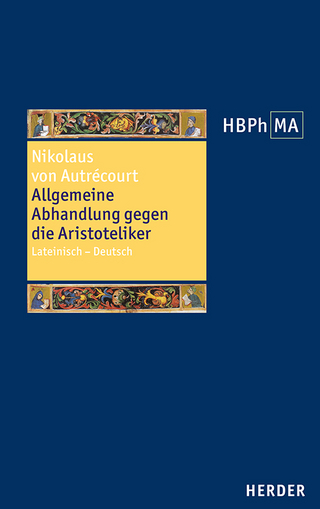
Khunrath in Context
Brill (Verlag)
978-90-04-22170-3 (ISBN)
- Noch nicht erschienen (ca. November 2024)
- Versandkostenfrei
- Auch auf Rechnung
- Artikel merken
The German physician, alchemist, kabbalist, and theosopher Heinrich Khunrath (ca. 1560–1605) is one of the most remarkable figures in the intellectual history of the Renaissance. His work, combining text and images in a new way, is a fusion of the contemporary currents of thought in which alchemy went hand-in-hand with philosophy and Lutheran heterodox theology. As a follower of Paracelsus, Khunrath was in search of both the secrets of nature and and the knowledge of God -- the “theosophy”. This
Prof. Vladimir Karpenko, Ph.D. (1975), Professor Emeritus of Charles University, studied biophysical chemistry and history of chemistry. He has published in scientific journals and authored a textbook and monographs on both physical chemistry and the history of alchemy. Ivo Purš, Ph.D. (2011), Charles University, Prague, is a Researcher at the Institute of Art History, Czech Academy of Sciences. He has published articles and monographs on visual art of Late Renaissance, alchemical iconography, and illustrations in science literature. Martin Žemla, Ph.D. (2010), Charles University, Prague, is a Research Fellow at Palacký University, Olomouc, and teaches at the Charles University. He has published articles, translations, and monographs on German Mysticism, Paracelsianism, and Renaissance Neoplatonism.
List of Figures
Introduction
1 Khunrath in the Context of History: Life and Work
1 Peregrinatio Alchemica
2 Education in Basel and the Thesis De signatura rerum naturalium
3 Stay in Bohemia and the De Interpraetatione Quorundam Accidentium
4 Overview of Works
4.1 Confessio de chao physico-chemicorum catholico
4.2 Symbolum physico-chymicum
4.3 Magnesia catholica philosophorum
4.4 Warhafftiger Bericht vom philosophischen Athanor
4.5 De igne magorum philosophorumque secreto externo et visibili
2 Khunrath in the Context of Renaissance Thought
1 Khunrath as a Paracelsian
2 The Metaphysics of Light
3 The Two Lights
4 Magic
5 Kabbalah
6 Alchemy
3 Khunrath in the Context of the Reformation
1 The Reformation and the “German Mysticism”
2 Paracelsus
3 Valentin Weigel
4 Heinrich Khunrath
4.1 Personal Revelations
4.2 Visions
4.3 Sophiology
4.4 Exegesis of the Bible and Genesis
4.5 The Three Divine Books
4.6 Allegory
4.7 The Deification of the Human and the “Performing of Miracles”
4.8 Rebirth of Man and Renovation of Things
5 Theosophy, and Rosicrucianism
4 Khunrath in the Context of Laboratory Alchemy (Von hylealischen Chaos)
1 The Theoretical Basis – Theosophical and Philosophical Aspects
1.1 Introduction
1.2 Primordial Matter, Magnesia and Chaos
1.3 The Recognition and Acquisition of Primordial Matter
1.4 Chaos, Light and Christ
1.5 The Green Lion and the Universal and Particular Stone
1.6 Two Ways of Working and the Methods Used
1.7 Primordial Matter, Adam and Sal Armoniacum
1.8 Mercurial Water and the Universal Solvent
1.9 The Philosophers’ Stone and Theological Symbolism
1.10 Laboratory Procedures and their Wrong Variants
1.11 “Be the way you want the stone to be”
2 The Practical Basis – the Alchemical and Chemical Aspects
2.1 Introduction
2.2 The World of Alchemy
2.3 Khunrath and the Tradition of Alchemical Secrecy
3 Khunrath as an Alchemist
3.1 Alchemical Theories
4 Magnesia, Vitriol, Antimonium
4.1 Magnesia
4.2 Vitriol
4.3 Antimonium
5 Alchemical Practice
5.1 “The Seeds of Metals”
5.2 The Effect of the Sun on the “Maturing” of Metals
5.3 Argenteitas and Aureitas
5.4 The Role of Fire and Furnaces
5.6 Some Laboratory Activities
6 Khunrath and Maier
6.1 Maier’s Case Against Fraudulent Alchemists
6.2 Comparing the Texts of Khunrath and Maier
6.3 An Examination of the Tools Used for Committing Fraud
6.4 The Differences between Khunrath’s and Maier’s Opening Statements
6.5 Descriptions of Various Fraudulent Techniques
6.6 Fraudster’s Explanations Based on Alchemical Theories
6.7 The Homunculus
6.8 Aurum Potabile
7 Conclusion
5 Khunrath in the Context of Alchemical Symbolism (Amphitheatrum sapientiae aeternae)
1 Introduction
2 Prologue to the Amphitheatrum
2.1 The First Level of the Prologue
2.2 The Second Level of the Prologue
2.3 The Third Level of the Prologue
2.4 The Fourth Level of the Prologue
2.5 The Fifth Level of the Prologue
2.6 The Sixth Level of the Prologue
2.7 The Seventh Level of the Prologue
3 The Iconography of the Engravings in the Amphitheatrum – the First Edition of 1595
3.1 Amphitheatrum and the Tradition of Medieval Educational Schemata
3.2 Text and Image in the Amphitheatrum’s Circular Engravings
3.3 Summary – Engravings One to Four
4 The Iconography of the Engravings in the Amphitheatrum – the Second Edition of 1609
4.1 Citadel of Alchemy
4.2 Crystal and Seal
4.3 Hermes’ Emerald Tablet
4.4 Gymnasium of Nature
4.5 Gate of the Amphitheatre of Wisdom
4.6 Summary – Engravings Five to Nine
4.7 Title Page, Khunrath’s Portrait and the Owl with Torches
5 The Engravings of the Amphitheatrum in the Context of Alchemical Iconography
5.1 An Overview of the Development of Alchemical Iconography up to the Seventeenth Century
5.2 Borrowed Elements in the Alchemical Iconography of the Amphitheatrum
5.3 Khunrath’s Alchemical Authorities
6 The Influence of Khunrath’s Educational Images on the Development of Alchemical Iconography
Conclusion
Bibliography
Index
| Erscheint lt. Verlag | 28.11.2024 |
|---|---|
| Reihe/Serie | Universal Reform ; 4 |
| Verlagsort | Leiden |
| Sprache | englisch |
| Maße | 155 x 235 mm |
| Gewicht | 1 g |
| Themenwelt | Geisteswissenschaften ► Philosophie ► Philosophie des Mittelalters |
| Geisteswissenschaften ► Religion / Theologie | |
| Sozialwissenschaften | |
| ISBN-10 | 90-04-22170-0 / 9004221700 |
| ISBN-13 | 978-90-04-22170-3 / 9789004221703 |
| Zustand | Neuware |
| Haben Sie eine Frage zum Produkt? |
aus dem Bereich


